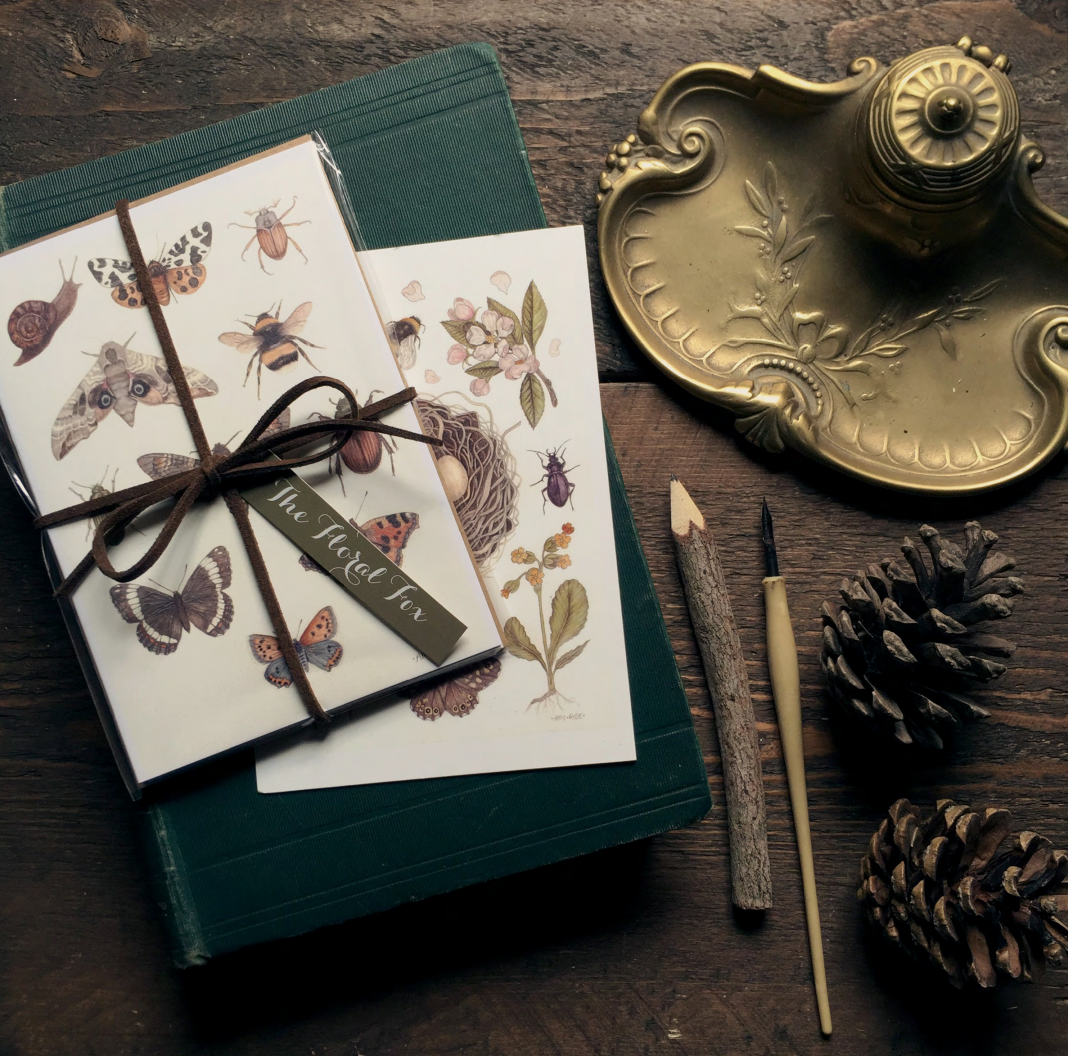Lilacs were not supposed to bloom in July, that was a simple botanical fact, at least it had been until now. Girls in the neighborhood had begun to whisper that if you kissed the boy you loved beneath the Owenses’ lilacs he’d be yours forever, whether he wanted to be or not … Scientists would park across from the driveway, mooning over the specimens they couldn’t get to, debating whether it was ethical to run across the lawn with some gardening shears and take whatever they wanted.
—Alice Hoffman, Practical Magic
Botanical art with a Victorian antique look is extremely popular these days not only with scientists with a fever for blooms and witches who need reference guides for their spell books but also with interior designers and homeowners who want to add a touch of mystery and history to their abodes.
Artist Amy Rose, or Floral Fox Art, is known for her lush botanical work. Laid out on the page like a collection from a cabinet of curiosities, vivid against a plain white or black background, her images make the viewer look more closely at the exquisite details of nature’s creations. Mixed in among the flowers, mushrooms, and leaves are often little items like keys or antlers, a dragonfly, or even a rusty pair of scissors. The resulting works seem almost like a story to be interpreted however you prefer, with individual images on the page spread out like hieroglyphics disclosing a secret science. We recently caught up with Rose between her trips to the fields and forests to collect and document more of nature’s mysteries.
Faerie Magazine: First, can you tell us a bit about your art, the style, and your medium?
Amy Rose: I’m an artist with an illustrative style. I try to give my work a vintage look but also capture the textures and colors of the plants and objects I paint. I collect lots of old natural history books and love to flick through them when I need inspiration. I use graphite and an old watercolor set that my dad gave me and that I’ve had for many years. I sometimes also use Photoshop to add color to the background and have a play with tones so I don’t ruin the original.
FM: You live in the Cotswolds, a region in England known for its exquisite beauty. How much effect do you think it has on your art?
AR: I’m lucky enough to live in a beautiful village surrounded by fields and countryside. The Cotswolds inspire my work all the time. I work closely with the seasons and the changing landscape. I often go on walks for inspiration and take pictures of the flora and fauna, but also collect nature finds like seed heads, leaves, feathers, and pinecones to study when I return home.
FM: Your work stands out among botanical artists for its whimsical and magical subject matter. The inclusion of antique objects in your art makes it seem like they’ve been combined with the botanicals to make up the ingredients to a mysterious spell. How do you decide what items to gather together for an arrangement?
AR: For my botanical work I look to nature for inspiration on which pieces go with what. I research the environment the plants and flowers live in, where they grow and what they grow alongside. The antique objects I’ve used in my art are all pieces I’ve collected over the years and are on display around my home, so it’s only natural that they find their way into my artwork.
FM: Have you had any encounters in nature while gathering botanical specimens or doing visual research that remain unexplained or seemed magical?
AR: One morning last year, I went for a walk near my home, and it was beautiful and frosty. I was out taking photos and collecting nature finds. When I went home, I noticed all the photos I had taken had green light orbs in them.
FM: Do you ever use the language of flowers or your knowledge of botanical specimens or lore to create a story within your selection?
AR: All the botanicals I choose for a piece will have a relationship with each other—whether it’s because they all grow in a certain type of woodland or in the same season.
FM: Do you have pets? And do you ever use them as subjects for your work?
AR: I tend to just draw what is in my natural British environment, so I haven’t drawn any of my pets yet. But I would like to draw and paint my chickens one day when the mood takes me. I have a pet rabbit called Winston who lives in the house with me and follows me everywhere, two chinchillas called Albert and Arthur, two turtles called Rory and Bertha, and three mischievous bantams called Ethel, Myrtle, and Betty.
FM: What are some of your favorite antique items in your collection?
AR: One of my favorite pieces is an old antique key that I found when I was a child in
my grandparents’ vegetable garden on the farm they lived on. I was only very young, but I have kept it with me ever since.
FM: If you could have a dream cabinet of curiosities, what would be inside?
AR: I think my dream cabinet of curiosities would be huge and include lots of natural history elements, such as small bones, shells, feathers, seed heads, fossils, moths, and crystals, but I also love old bottles, sea glass, antique tins, doll’s heads, and tintype photographs—anything unusual!
Discover Floral Fox Art’s natural world on etsy.com/shop/thefloralfoxart and Instagram @thefloralfoxart.


































